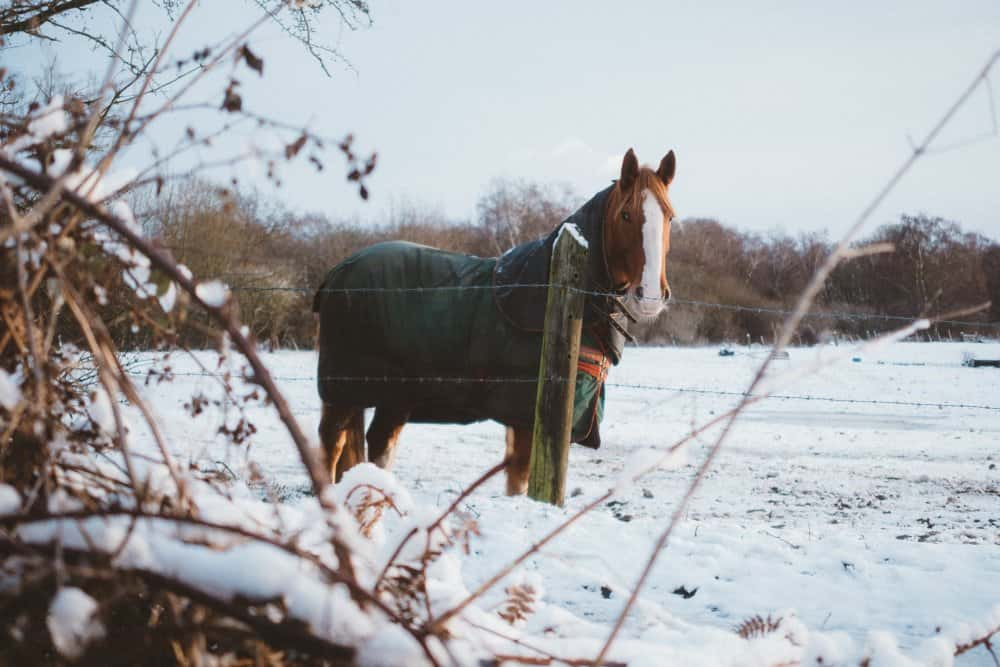As the temperature begins to plummet, you are probably busy swapping your 5-tog summer duvet for a thicker one, and digging out hats, scarves, and thermals so you are ready for those hardy stable visits. While horses can withstand far colder temperatures than us humans, horses are still mammals and they do still get cold. They will need some extra protection from the cold this winter, particularly from the wind and rain which are the elements which they can really struggle with. We look at the signs that may indicate your horse is cold and share some of the things you can do to ensure your horse is kept cosy and warm all winter.
Signs your horse is feeling cold
- He is shivering. Just like us, a horse will shiver when he is feeling cold.
- His winter coat is not as healthy as it should be. If a horse has been exposed to the rain, and not dried off properly can lead to a very cold horse. Plus, if your horse is not getting the fat and nutrition he needs in his diet, this will impact the condition of his skin and coat.
- He does not have enough fat on him/he is losing weight. If your horse is finding it hard to keep weight, or he has lost weight, he may be too cold. All his calories are being used, and he is tapping into his fat reserves to stay warm.
- He is huddling together with other horses. You might also see him running around more than usual in a bid to generate some body heat.
- His vitals are unusual. If a horse’s body temperature is as low as 98/99 degrees Fahrenheit (37.6 Celsius), hypothermia can set in.
- He is behaving unusually. You know your horse the best. If he is acting differently to normal, he may be trying to tell you he needs some help warming up.
Ways to warm up a cold horse
- Effective shelter
Providing shelter for horses is more about keeping them dry than anything else.If it rains or snows and horses get wet, the insulating properties of their skin and winter coat lose their effectiveness. Provide your pastured horses with an adequate outdoor structure for cover, where they can shelter in wet/snowy weather. You should also check the structure where they are stabled at night is leak free and waterproof. - Adequate feed
As we mentioned earlier, keeping warm requires energy and we get our energy from the calories we consume – horses are the same. It is common for horses to lose weight during the winter due to all the extra energy they are using to keep themselves warm. Having the proper feed is vital to achieving an insulative layer of fat underneath their thick winter coat.
Increasing the amount of hay your horse consumes during the colder months will help keep him warm inside and out. Hay is a ‘slow burn’ food for horses, meaning it is digested more slowly. Therefore, consuming hay produces larger amounts of body heat during digestion compared with grain. Your vet can help you decide how much hay to add to his diet. - Keep them hydrated
Freezing temperatureswill see your horse’s drinking water ice over quickly. Make sure you check and change your horse’s water supply regularly to ensure they are getting enough fresh water. Ice and snow are not adequate hydration for a horse and, if they become dehydrated, they will not have the required energy to keep themselves warm and healthy. - Invest in a horse rug
If you have provided all the above points, then you probably will not need a horse rug unless the temperatures outside are very extreme. While blankets and rugs are highly effective at keeping horses warm, they can sometimes lead to overheating. Plus, if they are not in great condition or are ill-fitting, they can rub, cause sores, or lead to bacterial infections.
At what temperature does a horse need a rug?
Most horses will not need rugging until temperatures plummet to 5-10°C unless they have recently been clipped, are living out 24/7, are feeling poorly, or are noticeably young/old. Equestrian clothing and tack experts, Equus, have put together a comprehensive temperature guide to rugging a horse to help you determine what type of rug is suitable and when.
However, this is just a guide. Every horse is different, and you should keep a close eye on your horse when wearing a rug to ensure that he is warming up and check he is not overheating.
Is my horse too hot under his horse rug?
If your horse is still feeling cold despite being tucked into his horse rugs, you will likely notice some or all the signs we mentioned at the beginning of this article. However, you should also be looking for signs that your horse might be feeling too warm. Signs your horse is too hot include:
- He is sweating. If you feel underneath your horse’s rug and find he is sweating, or feel wet behind his ears, it is time to remove the rug and try again with a lighter weighted variety. When a horse sweats, their coats become wet and, as we mentioned earlier, this affects the insulating properties of their winter coat. Not to mention that it can cause skin problems and general discomfort, as it does for humans too.
- Check his breathing. If he is breathing heavier than usual and it is not from exercise, then he is too warm. A lack of sweat can be a sign of overheating, so if your horse is breathing heavy and feels hot and dry, then remove the rug immediately and give him plenty of water to lap up.
- Signs of unusual behaviour. As we said before, you know your horse best. If he seems lethargic, less responsive, is lowering his head, or just generally seems out of sorts, it could be a sign that he is far too hot for his own good.
If you need help delivering on a high quality, waterproof, shelter for you beloved horse, our prima range of field shelters will ensure they are kept warm, dry, and comfortable year-round. If you are looking for a permanent stable structure, check our full stable range for inspiration.

Get in touch
Want to know more about choosing low-cost, high-quality stables? We’re happy to answer all your questions. Call 01233 884502, email info@nationalstables.co.uk or send us a message and we will respond ASAP.





